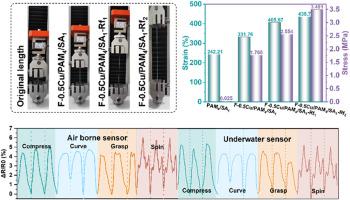Our official English website, www.x-mol.net, welcomes your
feedback! (Note: you will need to create a separate account there.)
Robust and low swelling polyacrylamide/sodium alginate dual-network hydrogels via multiple freezing strategy toward amphibious motion sensors
Polymer ( IF 4.1 ) Pub Date : 2024-11-14 , DOI: 10.1016/j.polymer.2024.127850 Shuangqing Li, Xinyi Ge, Zhenhai Zhong, Xiuling Dong, Zheng Xing, Ying Wei, Qingguo Zhang
Polymer ( IF 4.1 ) Pub Date : 2024-11-14 , DOI: 10.1016/j.polymer.2024.127850 Shuangqing Li, Xinyi Ge, Zhenhai Zhong, Xiuling Dong, Zheng Xing, Ying Wei, Qingguo Zhang

|
The swelling and disintegration behavior of conventional hydrogels in liquid environments significantly affects their mechanical and ionic conductive properties, thereby limiting their widespread application in underwater setting. Herein, we propose a multiple freezing (MF) strategy for the construction of polyacrylamide/sodium alginate (PAM/SA) dual-network hydrogels that exhibit excellent anti-swelling properties and high toughness. The MF strategy employs a combination of freeze casting and refreezing to promote a cascading enhancement of polymer network density, resulting in a highly dense polymer network. This dense network structure endows the hydrogel with impressive tensile strength (3.491 MPa), exceptional elongation at break (435.71 %), and high toughness (5.291 MJ m⁻3 ), along with remarkable ionic conductivity (142.75 mS m⁻1 ) and sensitivity (GF = 2.278). These properties enable the hydrogel to function as a flexible sensor capable of detecting various human movement patterns. Its excellent resistance to swelling makes it an ideal material for underwater sensors, effectively monitoring different swimming strokes. This strategy provides a straightforward and effective means to enhance the mechanical strength and adaptability of traditional hydrogels in aquatic environments, demonstrating significant potential for applications in underwater sensing.
中文翻译:

通过多种冷冻策略对水陆两用运动传感器进行稳定且低溶胀的聚丙烯酰胺/海藻酸钠双网络水凝胶
传统水凝胶在液体环境中的溶胀和崩解行为显着影响其机械和离子导电性能,从而限制了它们在水下环境中的广泛应用。在此,我们提出了一种多重冷冻 (MF) 策略,用于构建聚丙烯酰胺/海藻酸钠 (PAM/SA) 双网络水凝胶,该水凝胶表现出优异的抗溶胀性能和高韧性。MF 策略采用冷冻铸造和再冷冻的组合来促进聚合物网络密度的级联增强,从而产生高密度的聚合物网络。这种致密的网络结构赋予水凝胶令人印象深刻的拉伸强度 (3.491 MPa)、出色的断裂伸长率 (435.71 %)和高韧性 (5.291 MJ m⁻3),以及显着的离子电导率 (142.75 mS m⁻1) 和灵敏度 (GF = 2.278)。这些特性使水凝胶能够用作能够检测各种人体运动模式的柔性传感器。其出色的抗溶胀性使其成为水下传感器的理想材料,可有效监测不同的游泳泳姿。这种策略提供了一种简单有效的方法来增强传统水凝胶在水生环境中的机械强度和适应性,在水下传感中显示出巨大的应用潜力。
更新日期:2024-11-14
中文翻译:

通过多种冷冻策略对水陆两用运动传感器进行稳定且低溶胀的聚丙烯酰胺/海藻酸钠双网络水凝胶
传统水凝胶在液体环境中的溶胀和崩解行为显着影响其机械和离子导电性能,从而限制了它们在水下环境中的广泛应用。在此,我们提出了一种多重冷冻 (MF) 策略,用于构建聚丙烯酰胺/海藻酸钠 (PAM/SA) 双网络水凝胶,该水凝胶表现出优异的抗溶胀性能和高韧性。MF 策略采用冷冻铸造和再冷冻的组合来促进聚合物网络密度的级联增强,从而产生高密度的聚合物网络。这种致密的网络结构赋予水凝胶令人印象深刻的拉伸强度 (3.491 MPa)、出色的断裂伸长率 (435.71 %)和高韧性 (5.291 MJ m⁻3),以及显着的离子电导率 (142.75 mS m⁻1) 和灵敏度 (GF = 2.278)。这些特性使水凝胶能够用作能够检测各种人体运动模式的柔性传感器。其出色的抗溶胀性使其成为水下传感器的理想材料,可有效监测不同的游泳泳姿。这种策略提供了一种简单有效的方法来增强传统水凝胶在水生环境中的机械强度和适应性,在水下传感中显示出巨大的应用潜力。


















































 京公网安备 11010802027423号
京公网安备 11010802027423号